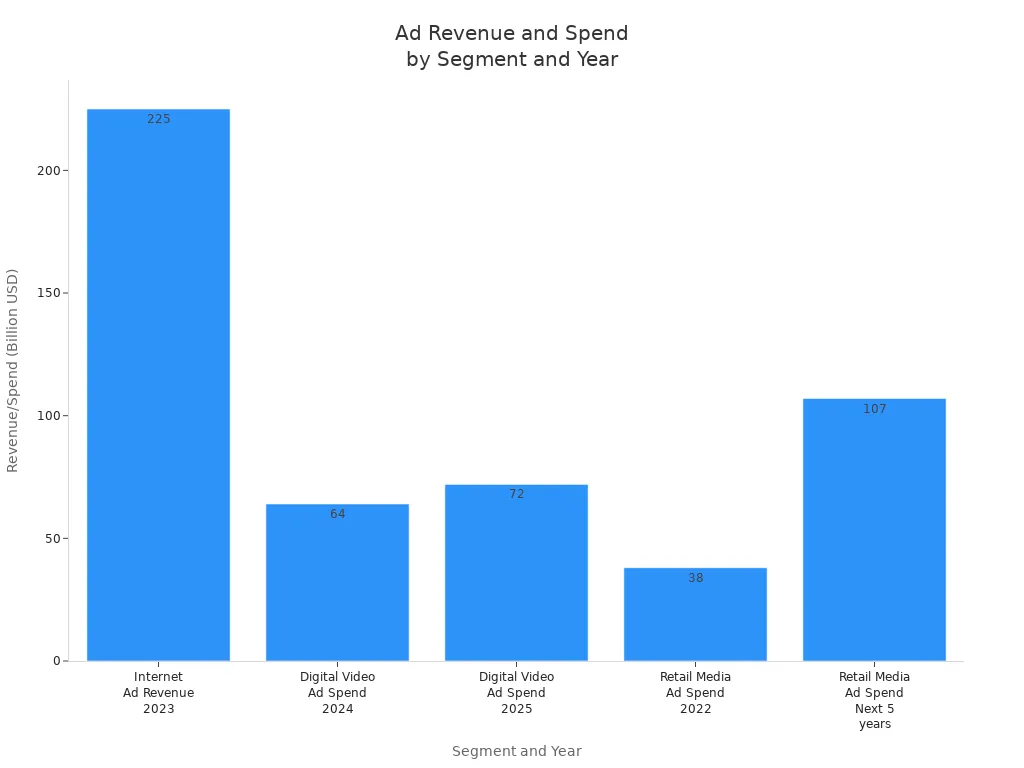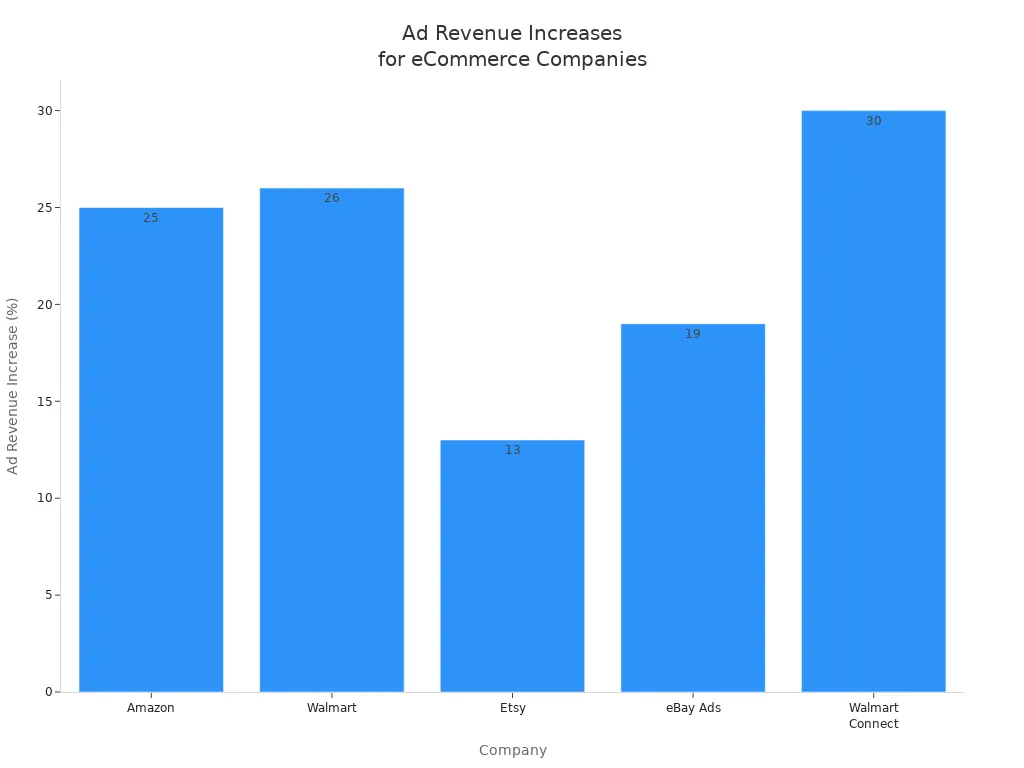
Real-world case studies demonstrate how revenue-generating ad tech helps companies increase their profits. HawkSEM ran a paid search campaign for California State University, Northridge, achieving 50% more leads while spending less money. Bloom agency assisted ADT UK in gaining 60% more conversions by using A/B testing and analyzing data. Companies like Inkbox and Airbnb saw more clicks and improved ROI by leveraging programmatic tools such as pixels and tag managers.
Readers will find concise stories that explain the problem, the solution, and the results. These stories highlight tips you can apply, showing how revenue-generating ad tech methods can help businesses grow and perform better.
Key Takeaways
Programmatic advertising and AI-driven ad tech help companies find the right people. These tools also help companies make more money from ads.
Real case studies teach us how clear goals and teamwork help. Using data also helps ads work better and helps businesses grow.
Smart tools like header bidding and audience segmentation help ads do better. Creative optimization also helps companies get more money back from ads.
Gaming, publishing, ecommerce, and mobile apps use programmatic strategies the most. These industries also watch important numbers to see how well ads do.
Testing often, making ads for users, and changing plans keep campaigns strong. These steps help businesses make more money over time.
Why Case Studies Matter

Learning from Success
Case studies are very important in ad tech. They give real examples that help marketers and leaders see how programmatic solutions work. Teams can look at these stories to learn how others fixed problems and found success.
The IAB UK’s ‘The Evidence’ series shares research and case studies from digital channels like gaming, digital audio, and connected TV. These help marketers make campaigns better and more effective.
Research from Finecast and University College London shows that targeted TV campaigns with programmatic advertising give strong brand benefits.
ShowHeroes and COG Research found that connected TV gets more user attention than other platforms. This shows the value of programmatic strategies in digital video.
Automated platforms look at big data sets. This helps with better targeting and using resources wisely. Programmatic advertising makes bidding automatic and picks the best placements. This helps get more conversions and better ROI.
Learning from what works helps teams use data, keep improving, and try new technology.
Case studies also help people make choices by teaching them, building trust, and showing real benefits. The table below explains how case studies help ad tech grow:
Aspect | Description |
|---|---|
Educating Decision-Makers | Case studies show benefits and uses, so people make smart choices. |
Showcasing Success Stories | Real stories build trust and show value. |
Visualizing Real-World Impact | Case studies help people see the good things, like more reach or lower costs. |
Addressing Challenges | They show ways to fix problems, like getting everyone to agree or training staff. |
Quantifying ROI | Clear money benefits help explain why to invest in programmatic solutions. |
Lessons Learned | Good tips help guide future programmatic advertising plans. |
Impact on Ad Revenue
Programmatic advertising has changed how companies make ad money. New programmatic tools, like header bidding and yield analytics, have helped publishers and advertisers earn more.
Header bidding makes things faster and helps manage bids, so yield goes up.
Testing bidstream signals with A/B testing can raise revenue by up to 40%.
Platforms like Amazon Publisher Services and RAMP give clear data and tools to help publishers earn more ad money.
Demand-side and supply-side platforms let advertisers bid in real time. This helps them reach the right people and sell ads for the best price.
Machine learning and data management platforms help target better and make campaigns work well. This can increase revenue by 4% to 40%.
Programmatic advertising helps many industries. The table below shows recent growth:
Metric | Value/Projection | Year/Period | Growth Rate/Notes |
|---|---|---|---|
Total Internet Advertising Revenue | 2023 (2022-2023) | 7.3% Year-over-Year growth | |
Digital Video Ad Spend | $64 billion (projected $72B) | 2024 (projected 2025) | 18% Year-over-Year growth in 2024 |
Retail Media Advertising Spend | 2022 | +22% Year-over-Year growth | |
Retail Media Advertising Spend | $107 billion (projected) | Next 5 years | Expected to more than double |

These results show that programmatic advertising helps ad revenue grow a lot. Brands that use programmatic strategies and learn from case studies can work better, earn more, and succeed for a long time.
Revenue-Generating Ad Tech in Action
Gaming Industry Case Studies
The gaming industry is a top user of revenue-generating ad tech. Many companies use programmatic advertising and smart tools to make more money and keep players interested. Some case studies show how these ideas work well.
A mobile game publisher used Meta’s Ad ROAS optimization. This led to a 378% higher Day 1 LTV. Retention went up by 15% on Day 1 and 12.8% on Day 3. The company made more ad money and saw better campaign results.
Hyper-casual games changed from install-optimized to Ad ROAS campaigns. They got a Day 7 ROAS of 20%. After 30 days, ROAS reached 100%, but install campaigns only got 50%. This doubled the return and made ad revenue better.
Hybrid monetization apps use both in-app purchases and ads. They ran Ad ROAS campaigns in places with low purchases but high ad use. These campaigns gave 1.3 times more ARPU than purchase-optimized campaigns.
The cost per install went up by about 20%. But the extra money from Ad ROAS users made up for the higher cost.
Tip: Creative optimization, smarter bidding, and bringing back high-value users help get the most eCPM and ROAS. Using marketing analytics and audience segmentation makes programmatic ads and ad setup better.
AppsFlyer’s Measurement Suite and ROI tools help gaming companies track and improve ad revenue. Fraud protection and privacy tools keep data correct and campaigns safe. These tools help gaming companies grow and get more customers.
Publishing and Media Case Studies
Publishing and media companies use programmatic advertising to make more ad money and give users a better experience. The table below shows two case studies about revenue-generating ad tech:
Company / Partner | Context / Challenge | Ad Tech Solution | Quantifiable Result |
|---|---|---|---|
Adelaide (Insurance Co.) | Needed to measure impact of attention on digital ads | Used Attention Unit (AU) metric to identify high-attention channels and optimize budget allocation | Ads with higher AU scores showed significantly higher conversion rates, linking attention metrics to business outcomes |
Setupad & azrhymes.com | Previous partner focused on ad density, causing user complaints and poor attention | Implemented user-centric ad placements optimized with attention metrics | 62% increase in ad revenue; improved site performance and user satisfaction |
Successful publishing campaigns use many programmatic strategies:
Limit ad clutter and keep ads relevant to keep users interested and get more clicks.
Make sure sites work well on mobile because more people use phones.
Use different ad types, like display, native, and outstream video, to fit content and audience.
Use data and analytics to target the right people and find top content.
Test ad placements, sizes, and creatives to get the best ad revenue.
Use programmatic advertising and ad exchanges to sell ad space automatically and raise CPMs.
Use header bidding to make auctions better and control revenue.
Make deals and join private marketplaces for premium ad spots.
Add other ways to make money, like subscriptions, affiliate marketing, and paid events.
Change prices to handle busy ad seasons.
Pick ad spots that are easy to see and click, like mid-content or below navigation bars.
Speed up websites with lazy loading for better user experience and ad views.
Always check and improve ad performance to get the most revenue.
Note: Knowing your audience, using contextual ads, and picking ad spots carefully help publishers make more ad money and succeed for a long time.
eCommerce and Retail Case Studies
Ecommerce companies have grown fast by using programmatic advertising and AI-powered ad tech. The table below shows ad revenue growth for top ecommerce and retail brands:
Company | Ad Revenue Increase | Year | Revenue Figures | Additional Metrics/Notes |
|---|---|---|---|---|
Amazon | 2023 | $46.9 billion | Surpassed YouTube’s ad revenue | |
Walmart | 26% year-over-year | 2023 | $3.4B (from $2.7B) | 32% brand awareness increase, 15% purchase intent boost |
Etsy | 13% increase | 2022 | N/A | Sellers saw 20% more store visits, 30% rise in sales |
Instacart | Ads = 30% of total revenue | 2022 | $740 million | Campaign ROI: 28-fold return |
Target (Roundel) | Over $1.5 billion annual revenue | 2023 | N/A | 40% higher conversion rate vs. standard display ads |
eBay Ads | 19% year-over-year | 2022 | N/A | Sponsored campaigns had 30% higher click-through rate |
Walmart Connect | 30% year-over-year in Q3 2023 | Q3 2023 | N/A | Forecasted to grow more than 40% next year |

AI-powered programmatic advertising has changed ecommerce. Retail media platforms like Amazon Ads, Walmart Connect, and Target’s Roundel make billions by using shopper data for programmatic ads. AI targeting uses first-party data to show ads to the right people. This helps get more clicks, conversions, and better return on ad spend. Retail media adds more profit and new ways to make money.
Tip: AI-powered retail media is better than old display ads for targeting, ROAS, and engagement. Dynamic creative optimization and real-time insights help ecommerce brands get the best results and more ad money.
AI-powered dynamic pricing tools, now used by 25–30% of European retailers, raise revenue by 5–10% and profit by 2–5%. Amazon changes prices about 2.5 million times each day with AI. This helps lower extra inventory and makes operations better. AI also helps with personal ads, shopper profiles, and predictions, all helping ecommerce ad tech success.
Mobile Apps and Creators
Mobile apps and creators use programmatic advertising, influencer marketing, and advanced ad tech to grow ad money and users. Influencer campaigns with brands like Bumble, Native, and New Balance show how working together brings in more money. Paid ads on TikTok, Meta, and Snapchat help apps and creators spend wisely and earn more.
App Peak’s case studies show that social media marketing, influencer partnerships, referral programs, and in-app ads boost downloads, engagement, and ad money. Key ways to make money include in-app purchases, banner and rewarded video ads, subscriptions, and partnerships. Making the app store page better and tracking conversions also helps revenue grow.
Some ad tech platforms help mobile apps and creators make more money and get more users:
AdPushup helped a client get 534% more ad money in six months, showing strong ad revenue optimization.
InMobi uses appographic targeting to make ads more relevant and interesting.
Chartboost works with 90% of top-grossing mobile game developers, giving high revenue share and good cross-promotion.
Unity Ads and ironSource joined to offer better mediation, analytics, and tools for game developers.
TapJoy, now part of ironSource, gives high eCPMs (over $1,000 for Android in the US) and many ad types, leading to high engagement and conversions.
Ad Tech Platform | Key Features & Strengths | Monetization/User Growth Evidence |
|---|---|---|
Large advertiser pool; supports banner, interstitial, native, rewarded ads; easy integration | High-quality ad demand across formats; widely used for maximizing revenue | |
Facebook Audience Network | Uses Facebook/Instagram data for precise targeting; supports native and rewarded video ads | High eCPMs, especially for native and rewarded video formats |
InMobi | Global reach, diverse ad formats, mediation | Access to premium global demand; appographic targeting improves ad relevance |
AppLovin | Focus on mobile games; 100+ demand partners; mediation platform MAX | Strong user acquisition and monetization capabilities |
Unity Ads | Integrated with Unity engine; specializes in rewarded videos and playable ads | Popular in mobile gaming; seamless integration boosts engagement and revenue |
ironSource | Known for rewarded videos and offerwalls; strong mediation and user acquisition tools | Used by top-grossing games; increases engagement and revenue via rewarded ads |
Chartboost | Popular in gaming; strong cross-promotion and transparent revenue sharing | Works with 90% of top-grossing mobile game developers; high revenue share (90-100%) |
TapJoy | Offers virtual currency rewards; wide ad format support; handles large traffic | High eCPMs (over $1,000 in US Android); strong engagement and conversion rates |
Note: Mixing influencer marketing, paid media, and creator partnerships brings more ad money. Using advanced ad tech and smart monetization helps mobile apps and creators succeed for a long time.
Programmatic Advertising Success

Programmatic Strategies
Programmatic advertising changed how brands reach people and make money. Companies use programmatic buying, audience segmentation, and real-time optimization to get better results. Many stories show brands make more ad money with these methods.
A German online platform used premium CTV inventory and real-time insights. This gave them a 7.2% lift in brand consideration and a 3.2% rise in purchase intent.
Using strategic supply intelligence and supply-side targeting cut cost per acquisition by over half.
The Economist used hyper-targeted programmatic ads next to the right content. This got them a 10:1 return on investment and 3.6 million actions in just nine days.
Lacoste used audience segmentation, creative optimization, and A/B testing in a programmatic display campaign. The campaign reached almost 20 million impressions and over 2,200 sales.
Audi mixed consumer data with dynamic ad creatives. This made conversion rates go up by 400% compared to regular ads.
Header bidding and AI-driven campaigns are now very important. These tools make ad delivery faster, improve targeting, and help make more ad money.
Programmatic targeting strategies help brands personalize ads for many people. Brands use private marketplace deals and programmatic guaranteed buys to save money and get better returns. They keep testing and updating creative ideas to make campaigns work well.
Measurable Outcomes
Programmatic advertising case studies show clear gains in ad money and user engagement. Brands track important numbers to see how well they do:
Metric | Before Programmatic Advertising | After Programmatic Advertising |
|---|---|---|
Revenue | $500,000 | $1,000,000 |
Conversion Rate | 2% | 5% |
Website Traffic | 10,000 visits/month | 50,000 visits/month |
Other important numbers are impressions, reach, click-through rate, cost per click, viewability, and frequency. Programmatic ads often double click-through rates and reach millions of homes. Brands also get more engagement and better ad spots.
A case study from zMaticoo showed 270% daily revenue growth and 122% daily query per second growth after using programmatic supply and audience scale. Local Now used advanced programmatic tools and saw a 282% year-over-year ad money increase. These results show that programmatic buying and real-time optimization help brands get better ROAS and ad money growth.
Note: Brands that use programmatic advertising and focus on data-driven audience segmentation get better results, higher ROAS, and long-term ad money growth.
Key Takeaways from Case Studies
Common Success Factors
Programmatic advertising works best when companies set clear goals. Teams that share data and make work easier get more ad money and website visits. Leaders who set clear KPIs for campaigns make sure ads help both customers and the company. Customer Success teams help clients link programmatic work to bigger business plans. This makes things clearer, lowers risk, and helps ad teams grow fast.
Product teams can use user actions to keep people coming back. For example, using programmatic tools to check product-market fit can spot customers who might leave. When programmatic ads match business goals, teams can track ROI, money earned, and time saved. These stories show that linking ad actions to big goals brings long-term growth.
Note: Companies that focus on making programmatic work better and tracking key numbers get stronger ad results and steady growth.
Practical Lessons
Begin each campaign with a clear plan that matches business goals.
Put the customer first by asking for feedback and knowing what users want.
Work together across teams to make programmatic work smoother.
Use data to pick the best ad spots and make ads fit users.
Be flexible and ready to change tactics to improve ads.
Keep learning and training to stay good at programmatic skills.
Use tech that fits the whole digital marketing plan for smooth ad delivery.
Make sure programmatic systems are safe and follow rules.
Track progress with clear KPIs like ROI, money earned, and website visits, and change plans if needed.
Build programmatic solutions that can grow as the business gets bigger.
Companies can make ad tech better by focusing on ad layout, how easy ads are to see, and user experience.
Good tips include moving ad spots, using templates for different pages, and making sure ads work well on phones.
Testing often, keeping campaigns steady, and having fast websites help get more clicks and sales.
Using many programmatic platforms and checking results with analytics keeps campaigns strong.
Adding video ads and personal calls-to-action gets more people to click and buy.
Tip: Using data, focusing on users, and always improving programmatic ads brings more ad money and better results over time.
Case studies show problems, solutions, and results with big numbers.
Using AI in smart ways helps brands connect with customers better.
Some ad tech platforms, like Setupad, can help ad money grow by more than 300%.
Companies that use digital ad plans keep growing, even when times are hard.
Businesses should check their ad tech to keep people safe and get better results.
Good ad tech helps brands get bigger, change when needed, and earn trust. Readers can tell their own stories or ask experts for help to find new ways to make money.
FAQ
What is revenue-generating ad tech?
Revenue-generating ad tech uses digital tools to help companies make more money from ads. These tools include programmatic advertising, AI-driven campaigns, and advanced analytics.
How do case studies help businesses choose ad tech?
Case studies show real results from other companies. They help businesses see what works. Companies can learn from these examples and make better choices about ad tech.
Why does programmatic advertising increase ad revenue?
Programmatic advertising uses automation and data to find the right audience. This helps ads reach the best people. It makes ad placement better and gets more people to click. Companies can earn more from each ad.
What industries benefit most from ad tech solutions?
Industries like gaming, publishing, eCommerce, retail, and mobile apps get strong results from ad tech. These industries use smart tools to make more ad money and reach more customers.
How can a business start using programmatic advertising?
A business can start by picking a trusted ad tech partner or platform. They should set clear goals and track important numbers. They need to try different ideas to see what works best.
See Also
How G37 Apple CarPlay Adapters Revolutionize Your Drive
Key Innovations Driving Android Auto Wireless Adapter Growth
Best Ten Wireless Apple CarPlay Adapters To Watch In 2025
